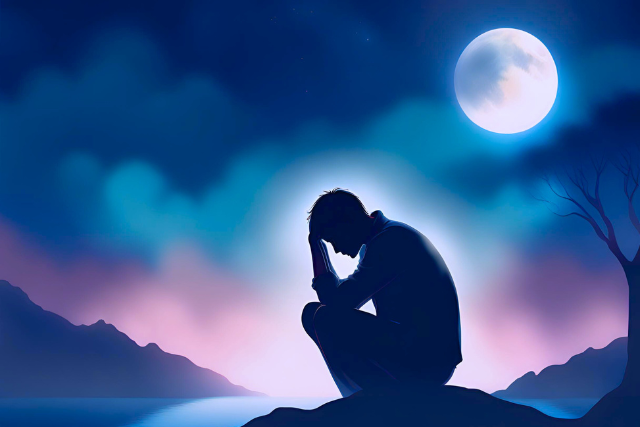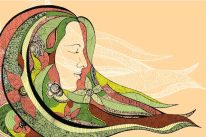
“Trauma is not the bad things that happen to you, but what happens inside you as a result of what happens to you.” ~Dr. Gabor Maté
I used to have this pervasive empty feeling inside. I tried filling it by eating, working, being a wife, making my life look great on socials—anything really to make it go away. I went to church, worked hard, and tried to be a good person, hoping the hole would fill and my life would feel whole and complete.
I went to therapy for the first time when I was sixteen years old. I remember telling my therapist about this black hole in the middle of my chest. It was bottomless and hot inside. I remember drawing it for my therapist, and one day we had a session where I went inside to see what was down there.
Strangely, I don’t remember the outcome of that session, but I do know that hole persisted for years. Well into my thirties. I would have seasons of time where I was more conscious of it than others, but nothing, no matter what I did or tried, would make it go away completely.
I went to school and became a therapist so I could learn all I could and help myself in ways others couldn’t help. Even with professional training, it still took a long time for me to sort out the bottomless pit that sat on my chest.
I realize now that the pit was composed of several different things, but the primary motivator behind its ever-presence was the fundamental belief that there was something wrong with me.
I believed everyone, in general, deserved to have a good life and good things, but I wasn’t so lucky. I didn’t really have a reason for why I believed this, just that this was my reality and I had to learn to live with it.
I didn’t believe that I deserved to have anything nice or good. My life was meant to be in service and sacrifice to others so they could advance and have a good life. Once I began to study trauma and its impact, I was finally able to put the pieces together for why I felt this way.
When we are kids, we don’t have any control over anything that is happening around us. We don’t get to say where we live, who we’re living with, where we go to school, or when we eat dinner. Nothing. The locus of control is completely outside of us.
We are at the mercy of the environment around us. For those of us who were not so lucky to be in an environment where we felt safe and secure and had our needs met, this presents a life-threatening problem.
We are mammals; we need connection for survival. It’s biological. When our safety and belonging are threatened, it feels like life or death because it is life or death. We need an attachment to our caretakers, our environment, and ourselves to survive.
Growing up, I wasn’t allowed to express emotion. If I was sad or angry, I had to pretend I wasn’t, or I would not be allowed to be in the presence of others in my home. I was abused by my cousins, and I had to keep it a secret so I wouldn’t upset the connections of the adults who were around me.
I was taught at church that if any boy was looking at me, touching me, or treating me badly, then I must be doing something to deserve it.
My world was completely out of my control, and I was drowning in helplessness, pain, sadness, and disconnection. This isn’t a tolerable emotional state to maintain. I couldn’t control any of it, and neither can any other child who is experiencing events that dysregulate their nervous system with no one and nothing available to help calm, soothe, and comfort.
We have only one choice in this instance. We shift the locus of control from outside of ourselves to inside of ourselves. We decide that we deserve bad things to happen.
There are many ways this plays out for people. Some people decide they are bad; they were born bad. Some people decide they just don’t deserve good things or to be treated kindly because there is something wrong with them. They, for whatever reason, are unlovable.
I fell more into the latter. I didn’t know what was wrong with me; I just knew something must be wrong with me, and that’s why so many bad things were happening to me and no one noticed or cared.
This resolved the conflict of feeling helpless and out of control. This allowed me to stay connected to my family in any way I could and removed the helplessness that left me feeling vulnerable and afraid.
We adopt the belief that bad things happen to bad people so we don’t have to be confused about why bad things are happening to us. It’s because we deserve it.
This is something we all do when we are young and in situations that are out of our control. We find a way to shift the narrative to make us in control. If we determine that we are bad, wrong, unlovable, weak, or in any way at fault, then the helplessness and weakness are resolved, and we can move forward creating connections and safety within our family systems and culture.
This sets in motion a paradigm, a core belief, that shapes all of our choices, interactions, assumptions, values, and practices for our whole life. This paradigm informs how we interact with the world moving forward. Buried inside the paradigm are deep feelings of grief, loneliness, shame, fear, and abandonment. These are intolerable feelings that are too overwhelming to keep in our conscious mind.
For me, I unconsciously dug a deep black hole in my soul and attempted to bury the insufferable feelings that had nowhere to go.
Trauma causes our minds and our bodies to split from each other. The lines of communication are severed or distorted in order for our stress response system to work effectively at keeping us alive.
If you experience a trauma but have the opportunity to process it and have people to help you recreate safety, then the connection between mind and body can be restored.
For those who experience trauma but don’t have the opportunity to re-establish connection and safety, the mind and body remain disconnected. With this persistent mind-body disconnection, the paradigm shift of internalizing that we are bad or deserve bad things gives us two choices moving forward.
One choice is to shut down all feelings and go numb to emotion. We live in our heads and work really hard to be perfect, good, lovable, pleasing, and acceptable. We become workaholics, overthinkers, perfectionists, and incapable of tolerating any mistakes we make.
We do this because we unconsciously want so badly to prove to ourselves and the world around us that we really are lovable and good people. We really are worthy of being loved and accepted. We love others well, struggle to set boundaries, and will do anything to be seen as acceptable.
I can relate very much to this response to the belief that there must be something really bad and wrong with me. I must have done something to deserve abuse and neglect. These weren’t conscious thoughts, just an internal shift I made as a child to resolve the unresolvable. This isn’t unique to me; every childhood trauma survivor I know has done this.
The other option we have is to stay connected more to our body than our mind. To emote and express all the sadness, anger, and rage inside. People with this response have big emotions. They are explosive, struggle with consistency, struggle to hold down a job, or have addictions. If you ask them why they are struggling, they will usually say, “I don’t know.” They really don’t know because they are in their bodies trying to express all the energy trapped inside, but their minds are checked out.
Some identify mostly with one archetype, and some relate to being both. This is more of a spectrum than a black-and-white response.
For me, I was numb 95% of the time and always in my head. If something did ever really get to me, then I would switch to big emotions and not think about what I was doing. I’d get blackout drunk, smoke a pack of cigarettes, buy $30 worth of candy, and eat it all in a half-hour. My behavior would be extreme until I could get back to my head and shut it all down. Can you relate?
While neither response is good or bad, our society definitely rewards one response over the other. We praise the children who sit in the front of the class and act like “teachers’ pets.” We reward the workaholics and praise the overthinkers. This makes me really sad now that I am in recovery from being a pleaser.
My recovery took years longer than it should have because it took so long for me to figure out that all the things that people told me were good about me were not actually me at all. They were all an attempt to prove my worth, and as long as I stayed connected to being seen as good and acceptable, I was playing a role based in shame rather than being myself. I couldn’t see it because the role was reinforced everywhere I went.
There are some specific steps we need to take to set ourselves free.
The first is to accept and feel the deep pain of realizing we were innocent children who had no control over the uncontrollable things that were happening.
We didn’t cause it and didn’t deserve it. We were innocent children who deserved love, protection, and safety. There is no reason inside of us that we didn’t get that.
This is often hard to accept. For me, it felt like I was going to die when I began to allow the pain to surface. This is because at the time of the events, the pain was threatening my connection, which threatened my life. That isn’t true anymore, but my younger self holding all the pain inside didn’t realize that until I began to let myself feel it.
No one cries forever, and no one rages forever; it does eventually pass. It didn’t kill me, and it won’t kill you either, even though it feels like it might.
My favorite quote from Dr. Colin Ross, the founder of The Trauma Model Theory, is “Feeling your feelings won’t kill you; it’s your attempt to not feel them that will.” I have found this to be such a helpful reminder in recovery from trauma.
The second step is to allow ourselves to fully grieve.
Expand your tolerance level for being uncomfortable and sitting with uncomfortable emotions. Learn to feel all your feelings without activating your stress response and going into fight, flight, or freeze. Be present with them in mind and body.
This can take some significant work for those who have had complex trauma in their histories. It often requires the support of a professional in the beginning. What helped me most is grieving what didn’t happen as much as what did. The connection and support I didn’t receive. The protection that wasn’t given to me, etc. Grieve the life you thought you should have had but didn’t.
The third step is shifting the responsibility (not blame) to where it belongs.
If we stay in the mindset of blame, it keeps us stuck in victim mode. We are working now to be responsible for our lives and how we move forward.
I hold my cousins responsible for their behavior. I hold my family responsible for the support they were not able to provide. I don’t blame them, but I don’t let them off the hook either. I don’t need to know if they’ll “pay” for what they did or didn’t do. I shift the responsibility for their behavior onto them and am not really bothered with their consequences or lack of them. It doesn’t matter to me.
It took me a while to be able to say that. For so long I wanted them to get it. I wanted them to understand, take responsibility, or say they were sorry. Waiting for these things to happen keeps us stuck and tied to them. It doesn’t allow us to move forward and create the future for ourselves that we want and deserve.
I am no longer taking responsibility for their choices, and I don’t need to think about or see how their future plays out.
The fourth step is to take full responsibility for ourselves.
This was a difficult step for me. I wanted to blame my past for my inability to speak up, be bold, take action, or feel someone’s disappointment.
I can’t take responsibility for myself and create the life I want to live if I refuse to accept that my life is a series of choices I make from here forward. I am empowered now to decide who will be around me, what I do with my time, and how I show up.
I have shifted the paradigm from the belief that I’m unworthy to the belief that I am just as worthy as anyone else. I can tolerate people being disappointed in me, frustrated by my choices, not liking me, or anything else. I decide how I want to show up every day, and I am the only one who can create my life.
I have never thought of myself as a victim. In fact, I hated the concept, but I did have to accept that living in pleasing mode meant I was also acting like a victim, and that alone was my motivation for change. It was messy and took a while, but eventually I was able to build my strength and resilience to a point where I was comfortable getting to know and expressing my authentic self.
The fifth step is giving ourselves the tools, grace, and time to let all this play out.
Continue to get to know who you truly are; continue to feel and express difficult emotions as they come up without pushing them away or dramatizing them. And learn to hold more than one emotion at the same time.
I can now feel true, genuine love for my family while also being sad and disappointed by the way some things went down. For me, it wasn’t all bad or all good. It was both, and through healing I can genuinely feel and connect to both.
I have also had to grieve the loss of time. It took many years for me to recover from the black hole that drove my choices and decisions for most of my life. I sometimes wonder what could have been if I had been able to be my authentic self earlier. When these thoughts come, I grieve them, let them pass, and then go do something I love to do.
It doesn’t matter how old we are when we recognize the paradigm. It can shift, but we are the only ones who can shift it for ourselves.
About Janice Holland
Janice Holland is a Certified Trauma Model Therapist who helps healers and professionals thrive without burnout through The Courageous Trauma Recovery Membership and her signature program, The Art of Healing Trauma. Follow her on Instagram @the.trauma.teacher.













 Though I run this site, it is not mine. It's ours. It's not about me. It's about us. Your stories and your wisdom are just as meaningful as mine.
Though I run this site, it is not mine. It's ours. It's not about me. It's about us. Your stories and your wisdom are just as meaningful as mine.